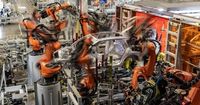China’s manufacturing sector has undergone a profound transformation in recent years, with the country now boasting more factory robots than the rest of the world combined. According to the International Federation of Robotics (IFR), over two million industrial robots were at work in Chinese factories by 2024, a figure that not only dwarfs the totals in other countries but also symbolizes China’s relentless push toward automation and technological supremacy. The scale and speed of this transformation are nothing short of staggering, and the ripple effects are being felt across global supply chains, labor markets, and the very nature of industrial competition.
The numbers tell a story of unprecedented growth. In 2024 alone, Chinese factories installed nearly 300,000 new robots, as reported by The New York Times and corroborated by the IFR. This figure is more than the combined total of new factory robots added in every other country that year. The United States, by comparison, installed just 34,000 robots during the same period, while Japan added 44,000. The gap is not only wide—it’s widening, as China’s strategy for automation continues to accelerate.
What’s driving this rapid expansion? The answer lies in a blend of government policy, strategic investment, and technical innovation. Since 2015, Beijing has made robotics a national priority as part of its "Made in China 2025" campaign, which aims to reduce reliance on imported advanced manufactured goods and elevate China’s status as a global technology leader. The government has poured public capital into the sector, offered low-interest loans, provided direct funding, and even encouraged the acquisition of foreign competitors. In 2021, a detailed national strategy for robot deployment was issued, further fueling the boom. As Susanne Bieller, general secretary of the robotics federation, put it, “You can see how well that strategy worked out; without a strategy, a country is always at a disadvantage.”
The impact of these policies is clear in the numbers. China’s share of the global robot manufacturing market rose to a third in 2024, up from a quarter the previous year. For the first time, nearly three-fifths of the robots installed in Chinese factories were domestically produced, marking a reversal from previous years when imports dominated. Japan, once the world’s top robot maker, saw its share drop to 29 percent, down from 38 percent the year before. This shift represents not just a quantitative leap but a qualitative transformation in China’s industrial capabilities.
The types of robots deployed in China’s factories are as varied as the industries they serve. Some robots perform heavy-duty tasks like welding car parts, while others handle more delicate assignments such as loading boxes onto conveyor belts. Increasingly, these machines are being integrated with artificial intelligence (AI) systems that optimize operations, track performance, and even predict maintenance needs. Cameron Johnson, a supply chain consultant in Shanghai, noted, “Companies in China are using AI to swoop in and say which machines are doing great and which are a little off. Outside of China, people aren’t looking at it as a manufacturing tool, at least not yet, and not how the Chinese are.”
This marriage of robotics and AI is reshaping the workforce as well. While some factories have reduced their reliance on human workers, others are redefining roles to focus on higher-skill positions like programming, maintenance, and system integration. The demand for skilled electricians, engineers, and programmers has surged, with salaries for robot installation specialists reaching nearly $60,000 a year—a significant sum in China’s labor market. Despite the country’s large pool of technical talent, even China has faced shortages of these specialists, underscoring how automation is shifting the labor landscape toward expertise rather than eliminating jobs outright.
The broader implications for global manufacturing are hard to ignore. By early 2025, Chinese factories were producing nearly a third of all manufactured goods worldwide, outpacing the combined output of the United States, Germany, Japan, South Korea, and Britain. This dominance is not just a matter of scale but of efficiency, as automation allows Chinese manufacturers to outpace competitors in productivity and cost-effectiveness. The result is a deepening structural imbalance in global manufacturing, with China setting the pace and others scrambling to keep up.
But the story doesn’t end with traditional factory robots. Government support has also led to a boom in startups making humanoid robots, such as Unitree Robotics, which plans to go public by the end of 2025. These humanoid machines—priced at around $6,000 in China, a fraction of the cost of American rivals like Boston Dynamics—remain largely in the experimental stage. Still, they point to the next frontier in automation. However, as Lian Jye Su, a chief analyst at Omdia, pointed out, Chinese firms still lag behind in producing some of the most advanced components for humanoid robots, such as sensors and semiconductors, which are primarily made in Germany and Japan. “If you were to assemble a really top-notch humanoid robot, it would be almost completely non-China-made,” Su observed. “Maybe it would have one or two Chinese components, but by and large the entire system would be very international.”
Even so, China’s advantages in factory robotics are formidable. The country’s vast numbers of skilled workers, strong AI industry, and government backing have created an ecosystem where automation can flourish. The shift from importing to manufacturing robots domestically not only saves costs but also fosters innovation and self-reliance. The emergence of a robust supply chain for robot components—everything from motorized joints to specialized software—further cements China’s leadership in this arena.
For other industrialized nations, the rise of China’s robot army poses both a challenge and a wake-up call. As robot installations fell last year in Japan, the United States, South Korea, and Germany, China’s trajectory continued upward. The lesson, according to experts and industry insiders, is that strategic planning, investment, and a willingness to embrace new technology are essential for staying competitive in the rapidly evolving world of manufacturing.
As the world watches China’s factories hum with the coordinated movements of millions of robots, the message is clear: automation is not just the future—it’s the present. And for now, China is leading the way, setting the standard for what a modern, automated manufacturing powerhouse can achieve.




